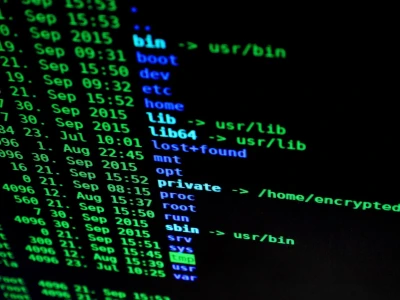
The recent emergence of the Interlock ransomware group has put Linux security admins on high alert, particularly those overseeing FreeBSD servers. Launched in late September 2024, Interlock sets itself apart by employing a custom-built encryptor designed specifically for FreeBSD, making it a significant threat for organizations relying on this operating system due to its prevalence in critical infrastructure. With six confirmed attacks, including a notable incident in Wayne County, Michigan, the ransomware's impact is already palpable.
To defend against such a sophisticated threat, Linux admins must adopt a multi-layered security strategy. To help you understand this threat and how to prevent attacks on your systems, I'll examine Interlock's attack approach and share practical mitigation strategies you can implement to secure your infrastructure and critical data.
Understanding Interlock's Approach
 Interlock Ransomware (source: MalwareHunter Team)Interlock stands out among other ransomware groups by targeting FreeBSD servers exclusively, particularly given the frequency with which this operating system is deployed in critical infrastructure sectors. While other groups often target Linux-based VMware ESXi servers instead, Interlock's 64-bit ELF executable developed specifically for FreeBSD 10.4 shows their comprehensive understanding of the environment and an intent to exploit systems not covered by recent security updates.
Interlock Ransomware (source: MalwareHunter Team)Interlock stands out among other ransomware groups by targeting FreeBSD servers exclusively, particularly given the frequency with which this operating system is deployed in critical infrastructure sectors. While other groups often target Linux-based VMware ESXi servers instead, Interlock's 64-bit ELF executable developed specifically for FreeBSD 10.4 shows their comprehensive understanding of the environment and an intent to exploit systems not covered by recent security updates.
Researchers studying Interlock have observed that, although initially, it had difficulty running smoothly in controlled environments, its functionality soon proved itself. Interlock employs traditional and advanced ransomware tactics - breaching networks, stealing and encrypting data, spreading laterally, and employing double-extortion techniques to coerce victims into paying ransom. Double extortion means after encrypting your files, attackers may threaten to release sensitive details publicly if your ransom payment isn't made immediately, adding another level of coercion towards victims!
The Importance of Multi-Layered Security Measures
Interlock underscores the necessity of employing multi-layered security measures to fortify Linux systems against attack. Protecting perimeters of networks is vital, and effective network and web application firewalls can assist with early detection and prevention of suspicious activities - serving as the first line of defense against potential breaches.
Intrusion detection systems (IDSs) play an integral role in monitoring network traffic for malicious activities and alert administrators of any unusual patterns that could indicate an attack, enabling swift responses. Furthermore, strengthening phishing defenses is crucial as most breaches begin with one or more emails with fake attachments that masquerade as legitimate emails. Teaching employees how to recognize and avoid phishing attempts combined with email filtering technologies can significantly decrease the chances of initial breaches.
Minimizing Privileges and Adopting Zero Trust Principles
 A key strategy in protecting against ransomware attacks is the principle of least privilege. This approach involves restricting user privileges so that only necessary permissions are given. Just-In-Time (JIT) access controls are also particularly helpful, reducing attackers' window of opportunity for exploiting compromised accounts.
A key strategy in protecting against ransomware attacks is the principle of least privilege. This approach involves restricting user privileges so that only necessary permissions are given. Just-In-Time (JIT) access controls are also particularly helpful, reducing attackers' window of opportunity for exploiting compromised accounts.
Zero Trust security models are also highly beneficial in stopping ransomware attacks, considering that threats may come from within and without. Therefore, every access request is rigorously verified regardless of its source, whether within or without organizational boundaries. By adopting Zero Trust principles, you can ensure users and devices verify their identities continuously, thus decreasing any damage from compromised accounts.
Isolating Workloads with FreeBSD Jails
Isolation is another key strategy for mitigating ransomware attacks, and FreeBSD's jail mechanism offers an effective solution. Utilizing jails allows applications to run in restricted environments that have minimal access to other parts of your system. This strategy makes spreading ransomware infections throughout your system much harder.
Operating workloads within isolated jails is an effective way of compartmentalizing the system, creating barriers that ransomware must pass through to cause widespread damage. Not only does this limit its attack surface, but it also facilitates quicker recovery as unaffected portions remain secure and operational.
Early Detection and Rapid Response
 Rapid detection and response are essential for preventing ransomware activities, and advanced monitoring tools provide invaluable assistance in quickly recognizing these harmful activities as soon as they emerge. Anomaly detection tools, in particular, are excellent at quickly alerting administrators when unusual patterns in network traffic or system behavior occur, providing timely alerts.
Rapid detection and response are essential for preventing ransomware activities, and advanced monitoring tools provide invaluable assistance in quickly recognizing these harmful activities as soon as they emerge. Anomaly detection tools, in particular, are excellent at quickly alerting administrators when unusual patterns in network traffic or system behavior occur, providing timely alerts.
Implementing a defense-in-depth strategy means layering multiple security controls throughout the IT environment to thwart potential attacks at various stages, from initial access and network penetration attempts to later-stage activities that move laterally within it. Multiple defense layers increase security and give security teams ample time to react appropriately.
Attaining Maximum Safety
No system can be completely safe from attacks. Thus, a comprehensive incident response plan is key for optimal system protection. Such plans must include clear procedures for responding to ransomware attacks, such as isolating affected systems, notifying stakeholders, and initiating recovery processes.
Regularly update and practice incident response plans to ensure your team can respond swiftly and effectively in an attack. Simulated exercises help identify gaps in response plans while strengthening coordination between response team members.
The Future of Ransomware Defense
 Cyber threats are constantly changing, and ransomware groups like Interlock are becoming increasingly sophisticated in their techniques. Staying ahead of these threats requires an aggressive stance on education and vigilance. This involves investing in training for IT staff members and cultivating an environment conducive to security within an organization, which are essential parts of an effective defense strategy.
Cyber threats are constantly changing, and ransomware groups like Interlock are becoming increasingly sophisticated in their techniques. Staying ahead of these threats requires an aggressive stance on education and vigilance. This involves investing in training for IT staff members and cultivating an environment conducive to security within an organization, which are essential parts of an effective defense strategy.
Adopting cutting-edge technologies like Artificial Intelligence and Machine Learning can significantly enhance your ability to detect and respond to threats. These advanced systems can analyze vast amounts of data in real time, quickly spotting anomalies that human analysts might miss. Integrating AI-powered tools into your security infrastructure will give you an edge in combatting ransomware attacks.
Our Final Thoughts on Protecting Against Interlock Ransomware
Interlock's targeted approach toward FreeBSD servers has highlighted an urgent need for higher security standards in critical infrastructure. Linux security administrators must rise to this challenge by adopting an extensive multi-layered security strategy which includes firewalls, intrusion detection systems, phishing defenses, privilege minimization mechanisms, workload isolation techniques, early detection tools as well as well-thought-out incident response plans that are regularly revised to address evolving threats.
Staying informed and proactive in today's dynamic cybersecurity landscape is paramount to staying safe from ransomware threats like Interlock. Implementing such measures and creating a security-conscious culture are effective strategies for organizations looking to minimize their exposure. Protecting themselves against one type of ransomware shouldn't be seen as the primary goal; building a resilient security posture that can withstand many types of attacks is what matters most.



















